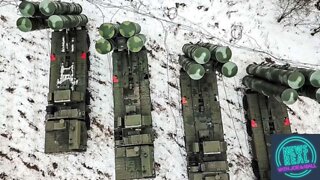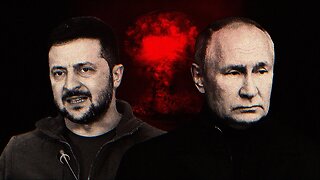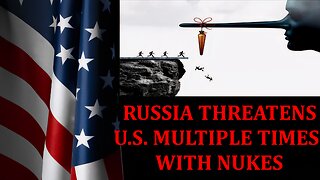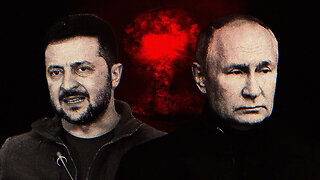A Major War Escalation With Nuclear Implications | Bongino News
Any conflict with a nuclear power like Russia carries the risk that nuclear weapons could be used, and President Vladimir Putin is aggressively exploiting such concerns. With its nuclear threats, the Kremlin is moving away from Russia’s doctrine that ascribes a protective role to its nuclear arsenal. In this way, Moscow aims not only to deter Western governments from providing more substantial support to Ukraine, but also to intimidate the Western public. However, as long as NATO does not intervene directly in Ukraine and the Russian regime does not feel existentially threatened, both intentional and unintentional nuclear use remain extremely unlikely. Nevertheless, Moscow’s nuclear threats still entail significant negative consequences. If Russia succeeds in using nuclear deterrence to shield an offensive conventional war, this could further destabilise Europe and the global security order.
The Kremlin has given the war in Ukraine an explicit nuclear dimension through various actions and statements. First, Russia conducted a manoeuvre with its nuclear forces in mid-February, shortly before the invasion. While it had been known for a few months that the exercise would take place in early 2022, the choice of timing seemed linked to the Ukraine crisis. After all, this annual exercise of Russia’s nuclear forces normally takes place in the fall, and Russian news coverage deliberately drew attention to the event. On February 24, the day Russia invaded Ukraine, Putin then warned in a speech that there would be unprecedented consequences should third states attempt to “obstruct” Russia. Such wording is traditionally considered to imply a threat to use nuclear weapons. The Russian president went further on February 27, announcing that Russia’s deterrent forces, which include nuclear weapons, would be placed on a “special regime of alert”.
This was the first time since the 1960s that Moscow had made such a public announcement regarding its nuclear alertness, even if its exact meaning was at first unclear. Indeed, some of the country’s strategic nuclear weapons are always on high alert and, hence, always ready to be used. Moreover, there are several levels of alert, ranging from purely administrative to very substantial, such as loading nuclear weapons onto heavy bombers. A statement by Russia’s Defence Minister Sergei Shoigu the next day indicated, however, that Putin’s announcement merely referred to an increase in personnel at some command centres and thus a comparatively minor measure. Nevertheless, shortly thereafter Russia conducted military exercises involving nuclear submarines in the Barents Sea and mobile intercontinental ballistic missile launchers in Siberia. Also, in early March, Russia’s Foreign Minister Sergei Lavrov noted somewhat vaguely that a third world war would certainly “be nuclear”. Nonetheless, during the following weeks, a number of Russian officials attempted to qualify or even roll back Putin and Lavrov’s remarks.
The West strongly criticised Moscow’s nuclear threats, accusing the Kremlin of fabricating artificial threats to Russia in order to justify further aggressive action. Washington warned Moscow against using nuclear weapons in Ukraine, but refrained from making similar public threats to Russia or raising its own level of nuclear alert. In addition, the United States postponed a planned missile test in order to avoid further rhetorical escalation.
Moscow Expands the Role of Its Nuclear Arsenal
According to Russia’s official doctrine, nuclear weapons primarily guarantee the country’s sovereignty and territorial integrity. The deterrence principles published in 2020 reflect this stance. Accordingly, Moscow would use its nuclear forces in the event of a nuclear attack on Russia and/or if the existence of the state were threatened by conventional aggression.
Putin’s announcements during the war against Ukraine, however, suggest that for Russia’s leadership, the function of its nuclear arsenal goes beyond the narrow defensive role set out in the official doctrine. Rather, the Kremlin seems to be using nuclear weapons to pursue expansive political goals. Indeed, Putin appears bent on shielding his conventional war of aggression under a nuclear umbrella. Through his threats, he seeks to deter outside actors from interfering and to keep the conflict at a level that Russia considers a “local war”. In this way, nuclear weapons are a tool of intimidation and of escalation management.
Moscow’s rhetoric thus suggests that it is interpreting its own nuclear doctrine more broadly. Putin justified his war of aggression by claiming that the United States was establishing a hostile “anti-Russia” in Ukraine, a supposed reality that in turn represented a matter of life and death for Russia. This threatened nothing less than the existence and sovereignty of Russia, he said – a formulation echoing Russia’s nuclear doctrine. Moreover, Putin accused Ukraine of developing nuclear weapons and other weapons of mass destruction, thereby further necessitating Russia’s intervention. This expansion of the doctrine and his own narratives appear to serve as a pretext for Putin to issue nuclear threats, even in the absence of a military threat to Russia.
Intentional Nuclear Use Remains Extremely Unlikely
In the current war, intentional or unintentional nuclear escalation has once again moved into the realm of possibility, as warned by UN Secretary-General António Guterres on March 14. The more one doubts Putin’s rationality, the greater these risks appear. Yet Russia’s decision to wage a war of aggression seems to have resulted not from irrationality but from faulty assumptions about its own capabilities, about the situation in Ukraine, and about Western solidarity with Kyiv. Therefore, it would make little analytical sense to outline scenarios on the premise of Putin’s irrationality, especially since this would allow for few viable policy choices. Despite Moscow’s threats, both conceptual nuclear strategy considerations and historical experience suggest that under today’s circumstances the probability of an intentional use of nuclear weapons remains extremely low.
First, Russia would face existential costs if it were to attack NATO states with nuclear weapons. For decades, Russia and the United States have relied upon the principle of mutual assured destruction. Both states have thousands of nuclear weapons that can be mounted on various delivery systems; and this is meant to ensure that even after suffering a massive first strike, the attacked would still be able to carry out a retaliatory second strike. The balance is maintained as long as neither dares to launch a disarming attack on the other. However, this also means that even a relatively limited use of nuclear weapons carries the risk of massive escalation. The result would be extreme destruction with global consequences disproportionate to Putin’s political goals in the war against Ukraine.
Second, even a limited use of nuclear weapons in Ukraine would fundamentally alter the nature of the conflict and the interests of third parties. Even if the United States wants the war to end, for Washington it currently remains a regional conflict posing only a limited threat to US security interests. The situation would be different if Russia were to use nuclear weapons against Ukraine. If Moscow succeeded in using such arms without suffering massive consequences, this would affect how other nuclear-armed states – such as China or North Korea – assess the costs and benefits of nuclear options. This would put the US system of alliances under extreme pressure, as it would heighten the threat perception of countries such as Japan or Poland. It would also fundamentally alter Washington’s interests – and thus its position towards military involvement – in the war in Ukraine. In addition, even Russia-friendly actors such as India or China would see their interest in sustaining a relatively stable international system threatened and would need to rethink their position vis-à-vis Moscow.
Third, Russia’s reputation would suffer enormously from a decision to carry out a nuclear strike. Indeed, it would be the first country to do so since 1945. This would run counter to Moscow’s long-standing interests in non-proliferation and would irrevocably transform Russia into a pariah state rather than its self-declared status as a guarantor of global stability. How the Kremlin assesses the risk of such a loss of prestige remains unclear, but it would, nonetheless, need to consider that its own population’s support for the war may dwindle.
Accidental Nuclear Use Remains Equally Unlikely
Even if there are no incentives to intentionally use nuclear weapons, there is still the possibility of unintended escalation. Such a scenario could arise, for instance, if one party to the conflict misinterprets risky steps taken by another, thereby setting into motion a dangerous dynamic. For example, the shooting down of a Russian fighter aircraft violating NATO airspace or the delivery of important military equipment to Ukraine could escalate the conventional conflict, which would in turn increase the risk of nuclear weapons use. Technical problems, such as faulty radar signals, could also cause a purely accidental escalation.
However, even in these scenarios, the risk of nuclear use remains low. Nuclear escalation would not occur automatically even in the event of a direct confrontation between NATO and Russia, as both sides have a vital interest in avoiding such an outcome. As long as neither Washington nor Moscow think that the other side could improve its position by using nuclear weapons, an inadvertent escalation remains unlikely.
Historical comparisons, for example with the Cuban Missile Crisis, are only of limited usefulness. In 1962, the United States was much more involved in the crisis as it took place in its immediate geographic proximity; it was more invested, not only with respect to its own influence and security interests, but also in terms of its readiness to potentially escalate the situation. In today’s war in Ukraine, by contrast, Washington is refraining from taking reciprocal counter-measures in response to Putin’s nuclear threats.
Moreover, in many early Cold War crises a conventional attack would inevitably have resulted in either a nuclear response or the loss of critical territory. Given Russia’s conventional superiority in Europe, the United States threatened that any conventional aggression there could lead to a devastating nuclear response. NATO’s principle of collective defence, its forward deployed US nuclear weapons and the fact that Europe, as one of the world’s three most important industrial centres, was critical to the US-led Western order, all lent further credibility to Washington’s commitment to follow through on this threat.
The current situation also differs from historical cases in the sense that, especially in the first phase of the Cold War, US-Soviet crisis communication channels were technically limited and central control over nuclear weapons was patchy. All of this suggests that while conventional conflicts could very well spiral out of control, they are unlikely to cross the nuclear threshold unless both sides take a number of additional escalatory steps – which currently remains a distant possibility.
Putin’s Intimidation Tactics
Russia’s nuclear rhetoric appears to be primarily a tool of intimidation and blackmail. By threatening such severe force, Putin is trying to compel others to accept his political demands. But who are these demands aimed at?
Russia is at war with Ukraine, but currently Kyiv does not seem to be the main target of Putin’s nuclear threats. Moscow would of course be able to completely destroy the country with nuclear weapons; but the Kremlin can only achieve its ostensible long-term goals – namely, establishing control over Ukraine, limiting its sovereignty and imposing a neutral status that prevents it from moving closer to the EU and NATO – through the use of conventional force. The extreme destructive power of nuclear weapons is not suitable to achieve these ends.
Even in the event of a Russian defeat in Ukraine, nuclear threats would not be credible and nuclear demonstration strikes would most likely be ineffective. Moscow would have to convincingly signal that it was prepared to either launch multiple nuclear strikes on the Ukrainian military or to destroy cities with nuclear weapons. Russia would thus need to convey its willingness to accept further disproportionate costs in its efforts to defeat Ukraine. The result would be a nuclear escalation that would be difficult to control. Other nuclear powers would need to respond to such a brazen violation of the international security order, and Russia’s international isolation would reach new heights. Putin’s speeches do suggest that Ukraine plays a major role in his imperial vision, but there is little to suggest that he would pay such a high price to obtain control over the country.
Moscow’s statements and actions in the current crisis support this logic. Putin has always directed his nuclear threats not at Ukraine but at the West. Their public nature also suggests that the threats are being addressed to the Russian and Western populations. With respect to its own citizens, the Kremlin must sustain the narrative that the West is hostile to Russia, and in doing so it justifies the high cost of sanctions. With respect to Western citizens, on the other hand, Moscow is probably seeking to intimidate them with the hope that they will exert pressure on their own governments to reject tough measures against Russia. The Kremlin has had some success in this regard, especially if one considers the lively discussions in Western media about the appropriate responses to the war, the palpable public concern about a potential nuclear attack and the wave of preparatory measures taken by some, including a run on iodine tablets.
-
 6:40
6:40
ShieldWall Defense
1 year agoChina's Nuclear Expansion and its Implications on Global Nuclear Order #china #chinamilitary #nuke
84 -
 2:19
2:19
RumbleCreater
1 year agoUS President issues dire warning of Putin's potential use of nuclear weapons | 9 News Australia
25 -
 0:21
0:21
Gen Z News
1 year agoBreaking News | Danger Ahead: NATO Policy Risks a Nuclear Showdown Between Russia and the West
10 -
 13:35
13:35
Lori Spencer
11 months agoNUCLEAR False Flag Event Imminent?
12 -
 27:44
27:44
Lori Spencer
11 months agoNuclear Catastrophe Averted?
17 -
 48:00
48:00
NEWS AND STUFF
1 year agoHow to Prepare for the HORRIFYING Reality of Nuclear War
61 -
 2:06:35
2:06:35
NewsReal with Joe and Niall
1 year agoNuclear Armageddon?! Nah, But Likely Expansion of War Beyond Ukraine
69 -
 10:18
10:18
azdenrf
1 year agoThe nuclear threat
68 -
 3:00
3:00
The Political Professor
1 year agoAre we going to have a nuclear war? (Originally published 9/3/222) #2 coming soon
34 -
 10:18
10:18
ShareNetCom
1 year agoNUCLEAR THREAT
1051